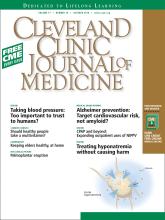Review
Taking blood pressure: Too important to trust to humans?
Donald G. Vidt, MD, Richard S. Lang, MD, MPH, Raul J. Seballos, MD, Anita Misra-Hebert, MD, John Campbell, MD and James F. Bena, MS
Cleveland Clinic Journal of Medicine October 2010, 77 (10) 683-688; DOI: https://doi.org/10.3949/ccjm.77a.09155
Donald G. Vidt
Chairman Emeritus and Consultant, Department of Nephrology and Hypertension, Cleveland ClinicMember, Seventh Joint National Committee on Prevention, Detection, Evaluation, and Treatment of High Blood Pressure
Richard S. Lang
Chair, Department of Preventive Medicine; Vice Chair, Wellness Institute, Cleveland Clinic
Raul J. Seballos
Vice Chair, Department of Preventive Medicine, Cleveland Clinic
Anita Misra-Hebert
Department of Preventive Medicine, Cleveland Clinic
John Campbell
Department of Preventive Medicine, Cleveland Clinic
James F. Bena
Department of Quantitative Health Sciences, Cleveland Clinic

ABSTRACT
The measurement of blood pressure in the physician’s office is subject to a number of observer errors and also to the “white-coat effect.” Automatic devices that measure blood pressure without a human observer in the room can eliminate many of these problems. We argue for greater use of these devices in the physician’s office.
- © 2010 The Cleveland Clinic Foundation. All Rights Reserved.
In this issue
Cleveland Clinic Journal of Medicine
Vol. 77, Issue 10
1 Oct 2010
Taking blood pressure: Too important to trust to humans?
Donald G. Vidt, Richard S. Lang, Raul J. Seballos, Anita Misra-Hebert, John Campbell, James F. Bena
Cleveland Clinic Journal of Medicine Oct 2010, 77 (10) 683-688; DOI: 10.3949/ccjm.77a.09155
Jump to section
Related Articles
- No related articles found.





